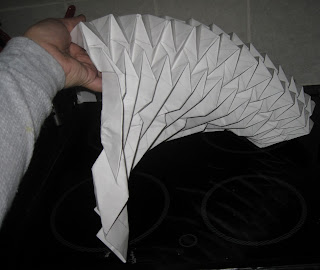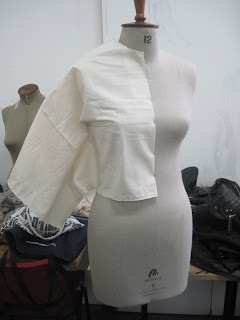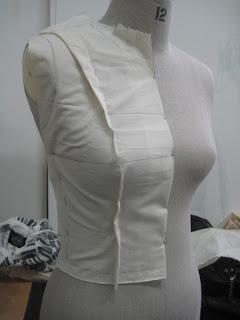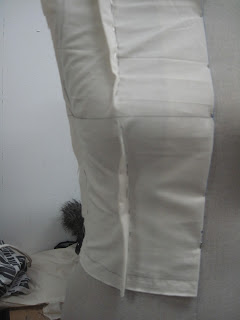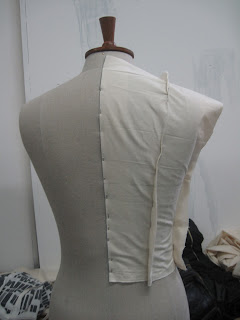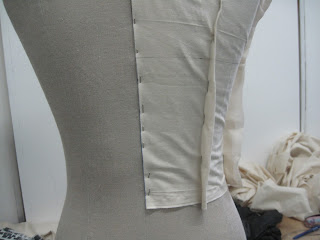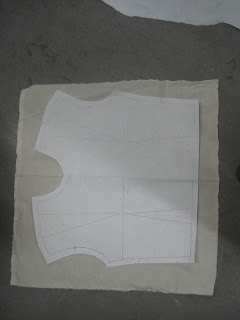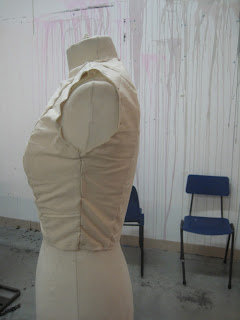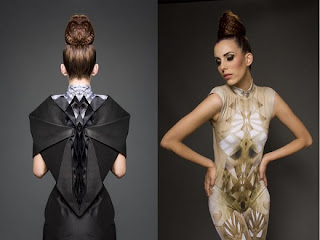The last two weeks of this module are dedicated in creating a wearable structure based on one or more techniques that we learnt all the last week. The most important thing is not just creating a garment but experimenting on the stand and finding out new interesting ideas. Coming to the class, I had some ideas already in my mind but from the beginning until the end of these weeks, the result was totally different but in a positive way. The thing I knew so that I could start up with something, was that I wanted to work with pleating and tights wrapped around a chair. In the meanwhile I decided to add a jacket deconstruction into my work so that I have a basic shape to start with. And so the preparation for the materials began. I started up with a complex pleating on a paper which finally was proven really difficult to feet the fabric in, I wrapped two chairs with tights( which the one of them I painted) in different styles and I bought a jacket that I started working with. At that time I came up with a design idea for a dress I could create, but in the process some plans changed.
 |
| First Idea |
 |
| chair mixed with other objects so that I can get a more interesting shape |
 |
| with tights |
 |
| with paint |
 |
| second chair |
 |
| the jacket |
Coming to the class, I stared experimenting with the jacket and working with creating layers over layers that did remind of accordion pleating , so that I could change the shape and the style of the jacket.
This took almost a whole day after I came up with this shape, and sewing it in some parts. Then I thought I wanted another pleating style for a basic in my dress so I made one more and I used the first one as a trial , in another smaller fabric. The new pleat that I then created, I used it as a sleeve and the small one which was not perfectly pleated I used as decoration. I changed the position o the jacket by using the one whole from which the sleeve was removed as entrance for the head so the collar automatically was transformed into a sleeve. The second sleeve that was left I though to use it as a decoration again so I came up with frou-frou shape over the chest.
When looking at the top that I had created, it reminded me of Victorian ages which I really love, so I was wondering how I can translate the style of that age into today's fashion. I designed one more dress that came to my mind.
 |
| Final decided idea |
I firstly added the yellow tights under the lower part of the jacket .For this idea I needed more tights and nice pleated fabric to use as a skirt.! I made one more chair with tights and I experimented on pleating velvet which I first thought would not work because of the weight of the fabric but surprisingly enough it was aesthetically unique elegant so I used it. When the tights where dry I cut them up in single lanes and I sewed them on a piece of calico which later I covered by sewing the velvet on so that only the ends of the tights were showing and the same time those worked as extra volume support for the skirt.




Now only the last details were left like adding a zipper on the back and caring about how the lower part would stand in the right height around the belly. This is when I sewed two pieces of fabric on the right and left of the dress and I connected the upper with the lower part.The last detail I did not forget was the neck decoration. I tried pleating again, in accordion style and fabric over fabric to make it look more dramatic. And the dress was done!!!
 |
| back view of the dress |
Good luck to all of us for Tuesday!
 |
| The final garment just before the runway show |













